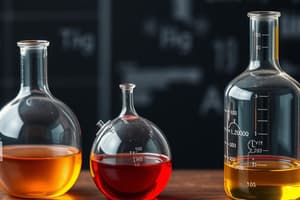Podcast
Questions and Answers
What is the purpose of determining the limiting reactant in a chemical reaction?
What is the purpose of determining the limiting reactant in a chemical reaction?
- To identify the reactant that is consumed first in a reaction
- To ensure all reactants are used up completely in a reaction
- To balance the chemical equation before proceeding with the reaction
- To calculate the efficiency and yield of a chemical reaction (correct)
How is percent yield calculated in chemistry?
How is percent yield calculated in chemistry?
- Actual yield divided by theoretical yield, then multiplied by 100 (correct)
- Theoretical yield divided by actual yield
- Theoretical yield divided by actual yield, then multiplied by 100
- Actual yield multiplied by theoretical yield
In the context of chemistry, what does Avogadro's number represent?
In the context of chemistry, what does Avogadro's number represent?
- The number of atoms in one molecule of a substance
- The number of particles in one mole of a substance (correct)
- The mass of one mole of a substance
- The maximum volume of a gas that can be measured accurately
Which term refers to the reactant that is entirely consumed during a chemical reaction?
Which term refers to the reactant that is entirely consumed during a chemical reaction?
Why is understanding stoichiometry crucial in predicting chemical reactions?
Why is understanding stoichiometry crucial in predicting chemical reactions?
How can stoichiometry be used to optimize manufacturing processes?
How can stoichiometry be used to optimize manufacturing processes?
What role do stoichiometric coefficients play in balanced chemical equations?
What role do stoichiometric coefficients play in balanced chemical equations?
In stoichiometry, what does the formula for stoichiometric calculations involve?
In stoichiometry, what does the formula for stoichiometric calculations involve?
What do we call the reactant that remains unreacted after the completion of a chemical reaction?
What do we call the reactant that remains unreacted after the completion of a chemical reaction?
What concept in stoichiometry helps in determining the relationships between reactants and products quantitatively?
What concept in stoichiometry helps in determining the relationships between reactants and products quantitatively?
Flashcards are hidden until you start studying
Study Notes
Stoichiometry: Understanding Balanced Reactions and Calculations
Stoichiometry, a critical branch of chemistry, helps us determine the relationships between the reactants and products of chemical reactions. In essence, it's the quantitative study of chemical reactions, providing a framework for calculating the amounts of substances involved in chemical processes. Let's dive into the fundamental concepts of stoichiometry and explore stoichiometric calculations, limiting reactants, percent yield, and the mole concept.
Stoichiometric Calculations
In stoichiometry, we rely on balanced chemical equations to determine the moles of reactants and products. These balanced equations show the stoichiometric coefficients, which represent the number of moles of reactants and products involved in the reaction. To perform stoichiometric calculations, we use the following formula:
[\text{moles of product} = (\text{moles of reactant}) \times (\text{stoichiometric coefficient of product})/\text{ (stoichiometric coefficient of reactant)}]
Limiting Reactants
A limiting reactant is the reactant that is entirely consumed during a chemical reaction, resulting in the formation of less product than the balanced equation predicts. Conversely, an excess reactant is the reactant that remains unreacted after the reaction is complete. To determine the limiting reactant, we can set up an equation using the stoichiometric coefficients and the moles of each reactant and solve for the moles of the product. The reactant with the least moles of product will be the limiting reactant.
Percent Yield
Percent yield is the ratio of the actual yield of a product to the theoretical yield of the product, expressed as a percentage. It represents the efficiency of a chemical reaction, taking into account factors such as side reactions, impurities, and incomplete reactions. To calculate percent yield:
[\text{Percent yield} = (\text{actual yield})/(\text{theoretical yield}) \times 100]
Mole Concept
The mole concept is a fundamental principle in chemistry that states that a mole is the amount of substance containing Avogadro's number (6.022 x 10^23) of particles (atoms, ions, or molecules). The mole concept allows us to convert between different units of mass, moles, and number of particles.
Understanding stoichiometry is crucial to our ability to predict, analyze, and optimize chemical reactions, manufacturing processes, and the synthesis of new materials. By learning these concepts, you'll be equipped to navigate the complexities of chemical reactions and harness the power of stoichiometry to your advantage.
Remember, stoichiometry is about precision and accuracy, so practice these calculations regularly to solidify your understanding of these fundamental principles. Happy studying!
Studying That Suits You
Use AI to generate personalized quizzes and flashcards to suit your learning preferences.




